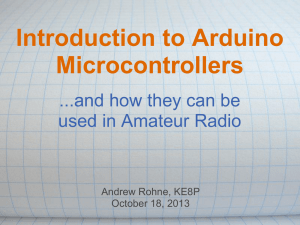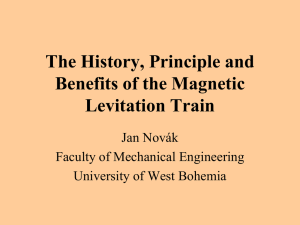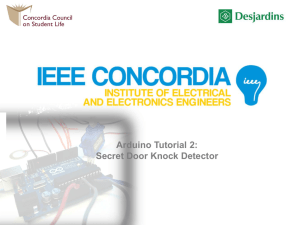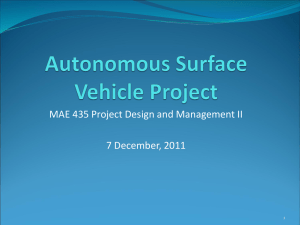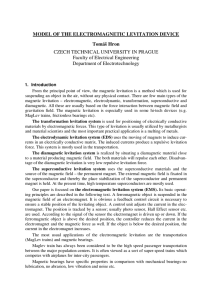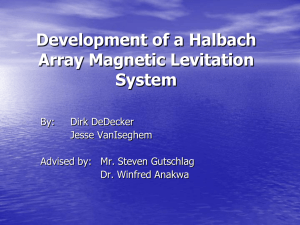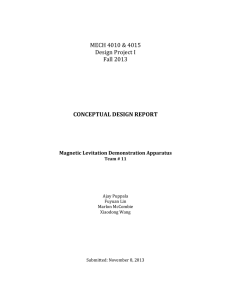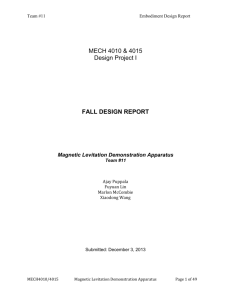magnetic levitation demonstration apparatus
advertisement
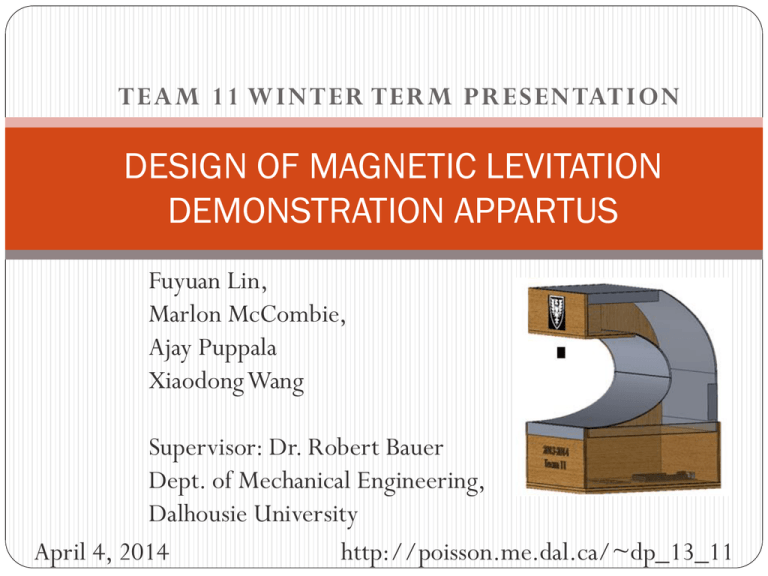
TEAM 11 WINTER TERM PRESENTATION DESIGN OF MAGNETIC LEVITATION DEMONSTRATION APPARTUS Fuyuan Lin, Marlon McCombie, Ajay Puppala Xiaodong Wang Supervisor: Dr. Robert Bauer Dept. of Mechanical Engineering, Dalhousie University April 4, 2014 http://poisson.me.dal.ca/~dp_13_11 Presentation Overview 2 Project Description Design Requirements Product Architecture Component Selection Conceptual Design 1. 2. 3. 4. 5. i. ii. Design Alternatives Chassis Design 6. Control System i. ii. iii. 7. 8. 9. 10. 11. Plant Subsystem Circuit Design: Amplifier & Driver Controller System Implementation GUI Budget Assessing Requirements Future Considerations 1. Project Description 3 Design and build a magnetic levitating device To levitate an object magnetically Demonstrate different control theories taught in MECH 4900 Systems II course Arduino (MCU) & Circuitry for Levitation Object Levitating 2. Design Requirements 4 Demonstrative Requirements Levitate object magnetically Compare simulated and experimental position of the object being levitated Lag, lead, lag-lead P, PI, and PID control User Requirements Graphical User Interface (GUI) to interact with device Plug ‘n Play Safe and Ergonomic 2. Design Requirements 5 Visual Requirements Viewable from 15- 20 ft. (back of the classroom) Levitate the object at least 2-4 cm away from the coil Power Requirements Conventional 120 VAC input No potential electrical risk to the user Operating Budget $1,500 3. Product Architecture 6 General Schematic of demonstration device 4. Component Selection 7 Levitation Object Technique Material Shape Motion Permanent Rectangular Chrome Steel Horizontal Magnets prism Electromagnets Electrodynamics Superconductors Regular Steel Circular disk Neodymium Solid sphere Composite Hollow sphere Vertical MCU Sensor Arduino Hall Effect LEGO Mindstorm NXT 2.0 Reflective BeagleBoard Optical Proximity Altera DE2 Photoelectric Table shows selected components of the subsystem Electromagnetic Levitation 8 Strength of magnetic field generated by the coil depends on the current supplied Control challenge: 𝐹𝐸𝑙𝑒𝑐𝑡𝑟𝑜𝑚𝑎𝑔𝑛𝑒𝑡 ∝ 𝑐𝑢𝑟𝑟𝑒𝑛𝑡 2 𝑑𝑖𝑠𝑡𝑎𝑛𝑐𝑒 2 Electromagnetic Levitation 5.1. Design Alternatives 9 1.Single Electromagnet with Hall Effect Sensor 2. Double Electromagnet Design 3. Multiple Coil Parallel Arrangement 5.2. Chassis Design 10 Design evolution of the chassis Material Aluminum 1060 Mass (kg) 3.95 ABS Plastic 1.50 Wood (Birch Ply) 1.20 Material options for the chassis Cost $235 $675 $126 6. Control System 11 Input Desired Position +_ Error Controller Current Unity Feedback System Plant Actual Position 6.1. Plant Subsystem 12 Current Levitation Position Change Sensor Breakdown of the Plant System Voltage Output Electromagnet Design Requirements 13 Air Gap, X = 20 mm, Object Mass = 20 g, ⟹ Fobject = 0.196 N Coil Turnings, N = 1000 For pole D = 3 cm, πD2 4 ⟹ A= =0.00071 m2 Permeability of free space, μo = 4π × 10−7 Vs Am Electromagnet Selection 14 Height of the electromagnet Core Diameter Cu wire gage Coil Turnings Field Strength Design Criteria 12 VDC Pneumatic Solenoid < 7 cm 3.65 cm 3 cm Max. 22 (Dia. 0.645) 1000 2 cm Dia. 0.65 0.0833 wb/𝑚2 ~2000 -Satisfactory Test Results -No heat issues Assessment of 12 VDC Pneumatic Solenoid based on design requirements 6.1. Plant Subsystem 15 Current Levitation Position Change Sensor Voltage Output Breakdown of the Plant System Hall Effect Sensor Sensor Component 16 Hall Effect Sensor Analog position sensor (Solid State Type – SS49 Series) Size: 30 x 4 x 2 mm Range of Detection: up to 4 cm Unit Cost: $2.50 Picture Courtesy of Honeywell. Design Refinement 17 Initial Design Final Design Addition of new Hall Effect Sensor to differentiate Electromagnet signal Sensor Testing 18 Sensor Circuit Design 19 Circuit for Differential Amplification of Sensor Ouput 6.1. Plant Subsystem 20 Current Levitation Voltage Sensor Position Change Measurement Output Sensor Calibration Actual Position 2 Hall Effect Sensors Position Sensor Calibration 21 Hall Effect Sensor Calibration Sensor Voltage (V) 3.50 3.00 2.50 2.00 1.50 1.00 0.50 0.00 0 20 40 60 80 Actual Distance (mm) 100 120 6.3. Control System 22 Input Desired Position +_ Error Controller Current Unity Feedback System Plant Actual Position 6.3. Controller Component 23 Microcontroller - Arduino Mega 2560 4 – Hardware serial ports for communication with MATLAB Runs control algorithms Cost: $55 Picture Courtesy of Arduino 7. System Implementation 24 Receive Data Levitation Control Serial Communication Arduino & Real Time • Arduino uses feedback data from sensors to manipulate position MATLAB & Arduino • Manipulation of control parameters • Retrieval of feedback data 8. PID Controller 25 8. Budget Materials Unit Cost Amount Arduino Hall Effect Sensor Potentiometer Operation Amplifier Power Supply Unit Neodymium Magnet USB Cable Electromagnet Other Parts $55.09 $2.64 $27.40 $0.64 $77.42 $4.99 $6.00 $14.95 - 3 20 2 5 1 2 4 - Wood (61 x 121 x 2.5 cm ) Acrylic glass Aluminum sheet Other Parts $6.15 $13.99 $15.93 - 26 Cost ELECTRONICS $165.27 $42.78 $54.80 $3.20 $77.42 $4.99 $12.00 $38.97 $55.51 CHASSIS Summary of Materials Cost 3 2 1 Sub Total $18.45 $27.98 $15.93 $22.38 $564.09 8. Budget 27 Sub Total $564.09 Total Shipping $85.11 Total Taxes $65.14 Contributions -$150.00 Total $564.34 Summary of Budget 9. Assessing Requirements 28 Demonstrative Requirements Levitate object magnetically ~ Compare desired and measured controller variables Lag, lead, lag-lead compensation techniques P, PI, and PID control User Requirements Graphical User Interface (GUI) to interact with device Plug ‘n Play Safe and Ergonomic 9. Assessing Requirements 29 Visual Requirements Viewable from 15- 20 ft. back of the classroom Levitate the object at least 2-4 cm away from the coil Power Requirements Conventional 120 VAC input No potential electrical risk to the user Operating Budget $1,500 10. Future Considerations 30 Build more powerful electromagnet or add an extra electromagnet to repel the levitated object – Might increase the range of levitation. Implementation of lag, lead, and lag-lead compensator. Use different microcontroller capable of serial or other form of communication without effecting the frequency of the feedback signal. Use different interface instead of MATLAB for example LabView Acknowledgements 31 Dr.Y.J. Pan Al-Mokhtar O. Mohamed Post-Doctoral Position Mech. Dept. Mechanical Dept. Professor Jonathan MacDonald Electrical Technician Dr. Timothy Little Angus MacPherson Mechanical Technician Electrical Dept. Professor Reg Peters Wood Workshop Technician 32 Thank You & Questions? References 40 Arduino UNO webpage. http://arduino.cc/en/Main/arduinoBoardUno. Retrieved Mar. 30, 2014 ATmega238 datasheet. http://www.atmel.com/Images/doc8161.pdf. Retrieved Mar. 30, 2014 Honeywell SS49 datasheet. http://www.wellsve.com/sft503/Counterpoint3_1.pdf. Retrieved Mar. 30, 2014 "RobotShop : The World's Leading Robot Store." RobotShop. N.p., n.d. Sun. Mar. 30, 2014 “MathWorks MATLAB/Simulink website.” http://www.mathworks.com/products/simulink/. Retrieved Mar. 30, 2014 Mikonikuv Blog, “Arduino Magnet Levitation – detailed description.” http://mekonik.wordpress.com/2009/03/17/arduino-magnet-levitation/. Retrieved Nov. 20, 2013 Williams, Lance. "Electromagnetic Levitation Thesis." N.p., 2005. Web. 28 Oct. 2013. Control System Question System Model 𝑚𝑜 = 0.02 𝑘𝑔, 𝑥𝑜 = 0.02 𝑚, 𝑖𝑜 = 0.738 A Ball Model: Force Balance 𝐹𝑛𝑒𝑡 = 𝑚𝑎, 𝑚𝑥 = 𝑚𝑔 − 𝐹 𝑖2 𝐹(𝑖, 𝑥) = 𝐶 2 𝑥 For change in position, 𝑥 = 𝑥 − 𝑥𝑜 𝑖2 Inverse Square Law! 𝑚𝑥 = 𝑚𝑔 − 𝐶 2 𝑥 2 2𝑖𝑜 2𝑖𝑜 𝑚𝑥 − 𝐶 𝑥 = −𝐶 𝑖 3 2 𝑥 𝑥 𝑜 𝑜 2 Static equilibrium: 𝑚𝑔 = 𝐶 Magnetic Plant Constant: 𝑖𝑜 𝑥𝑜 2 𝑚𝑔𝑥𝑜 2 𝑁𝑚2 −4 ⟹C= = 1.441 × 10 𝐴2 𝑖𝑜 2 Linearization of electromagnetic force using Taylor series approximation: 𝑖2 𝐶 2 𝑥 𝑖2 𝐶 2 𝑥 𝑖𝑜 2 =𝐶 2 𝑥𝑜 𝑖𝑜 2 =𝐶 2 𝑥𝑜 −𝐶 −𝐶 Electromagnetic Force 2𝑖𝑜 2 𝑥𝑜 3 2𝑖𝑜 2 𝑥𝑜 3 𝑥 − 𝑥𝑜 + 𝐶 𝑥−𝐶 2𝑖𝑜 𝑥𝑜 2 𝑖 2𝑖𝑜 𝑥𝑜 2 (𝑖 − 𝑖𝑜 ) Thus, the differential equation: 𝑥 − 3695 𝑥 = − 63 𝑖 2 ⟹ 𝑠 𝑋 𝑠 − 26.59𝑋 𝑠 = −0.536 𝐼 𝑠 𝑋 𝑠 𝐼 𝑠 = −0.536 𝑠 2 − 26.59 System Model Electromagnet Model Electromagnetic coil driving circuit System Model 𝐿 = 87 mH, 𝑅 = 17.5 Ω Electromagnet Model 𝑑𝑖 − 𝑉𝑜𝑢𝑡 = 0 𝑑𝑡 𝑑 𝑉𝑜𝑢𝑡 𝑉𝑖𝑛 − 𝐿 − 𝑉𝑜𝑢𝑡 = 0 𝑑𝑡 𝑅 Laplace transform: 𝐿𝑠 𝑉𝑖𝑛 (𝑠) − + 1 𝑉𝑜𝑢𝑡 (𝑠) = 0 𝑅 Rearranging the equation 𝑉𝑜𝑢𝑡 1 = 𝐿 𝑉𝑖𝑛 𝑠+1 𝑅 Finally, ∵ 𝑉𝑜𝑢𝑡 = 𝐼 𝑅 : 𝑉𝑖𝑛 − 𝐿 Simplified Circuit 1 𝐼 0.057 𝑅 = = 𝐿 𝑉𝑖𝑛 0.00497𝑠 + 1 𝑠+1 𝑅 Control Systems Electromagnet Voltage Input Plant (Levitation) Position Change Ball Combination of Electromagnet & Ball Model 𝐼 𝑠 𝑋 𝑠 𝑋 𝑠 × = 𝑉 𝑠 𝐼 𝑠 𝑉 𝑠 Thus, the uncompensated system 𝑋 𝑠 0.057 0.536 𝑂𝐿𝑇𝐹 = = 0.00497𝑠 + 1 𝑠 2 − 26.59 𝑉 𝑠 Note: Negative controller gain is required

